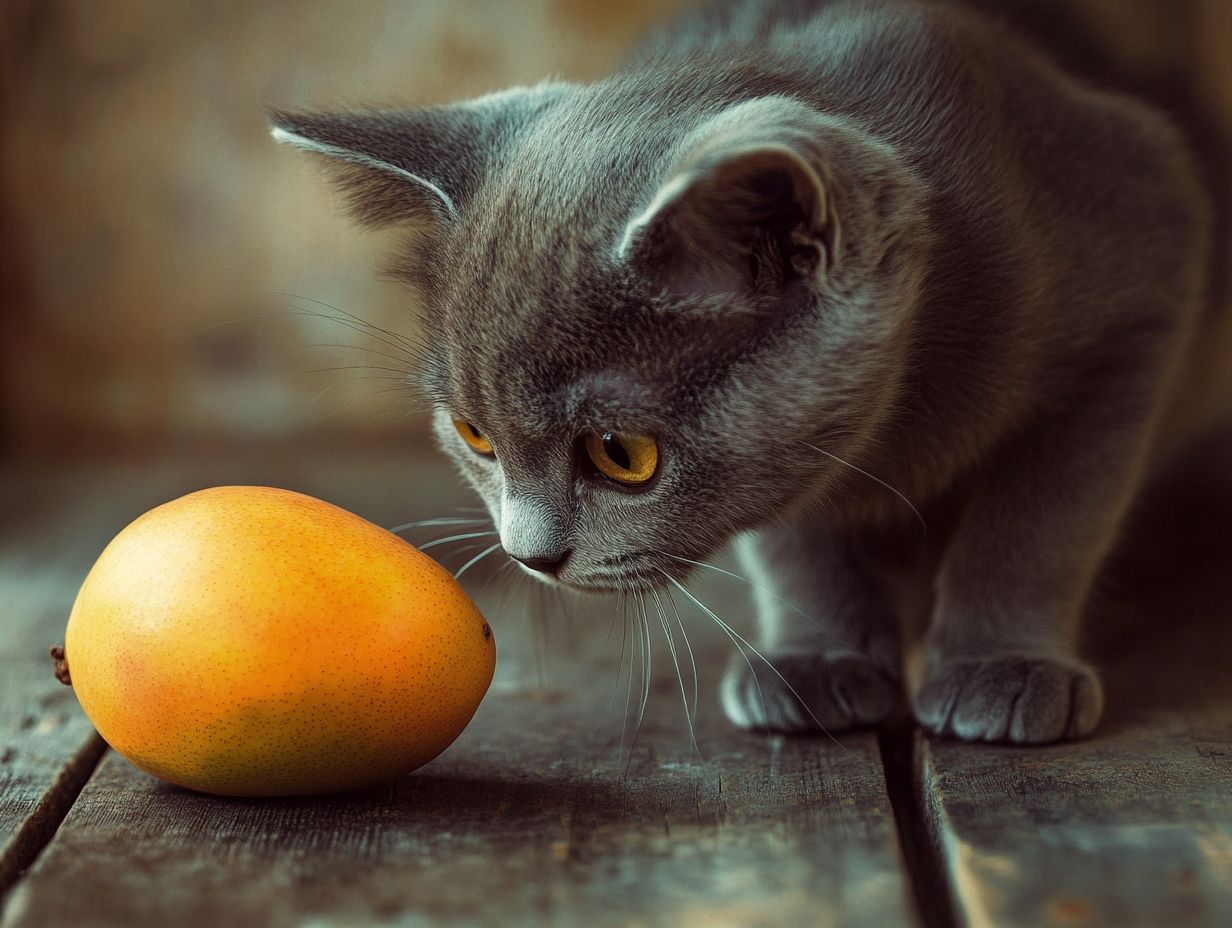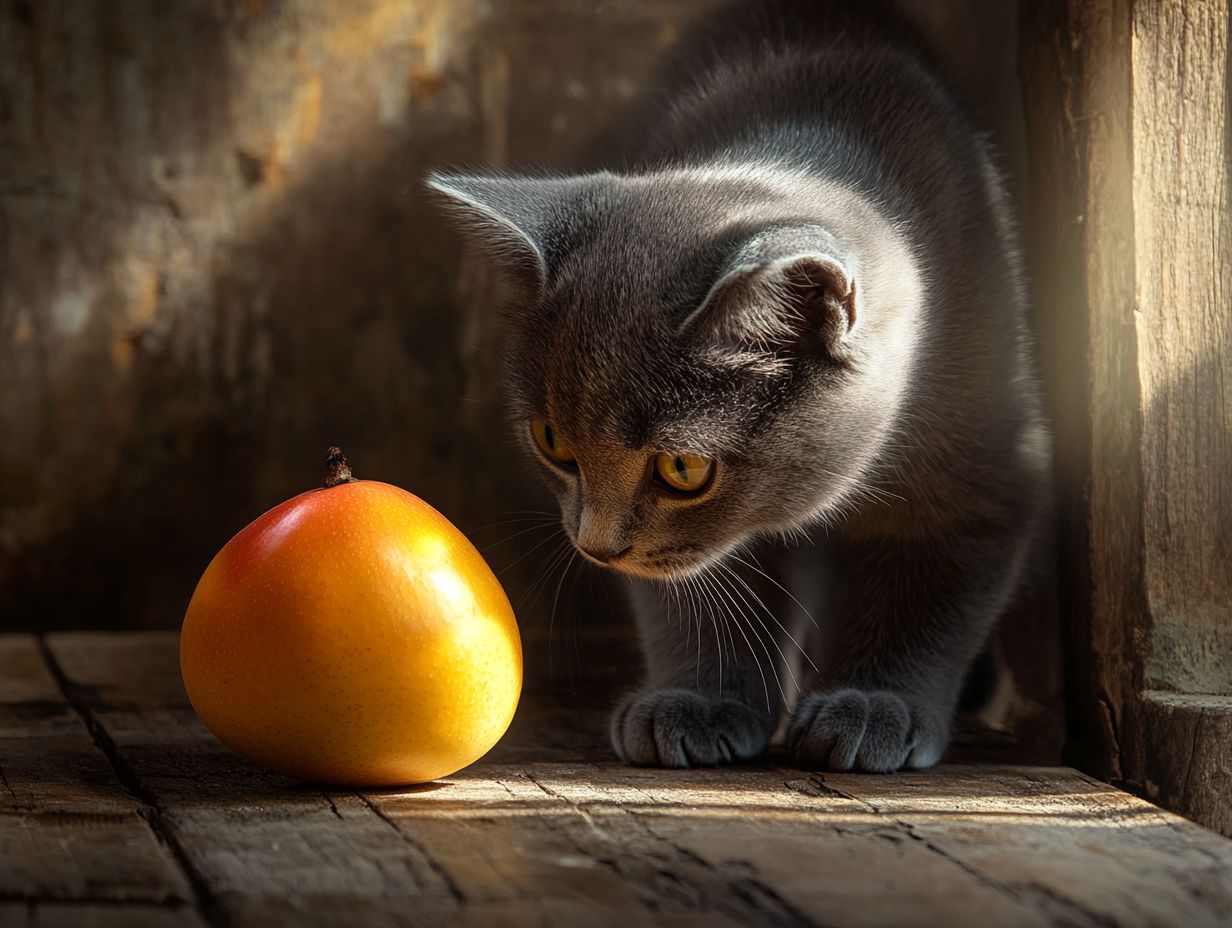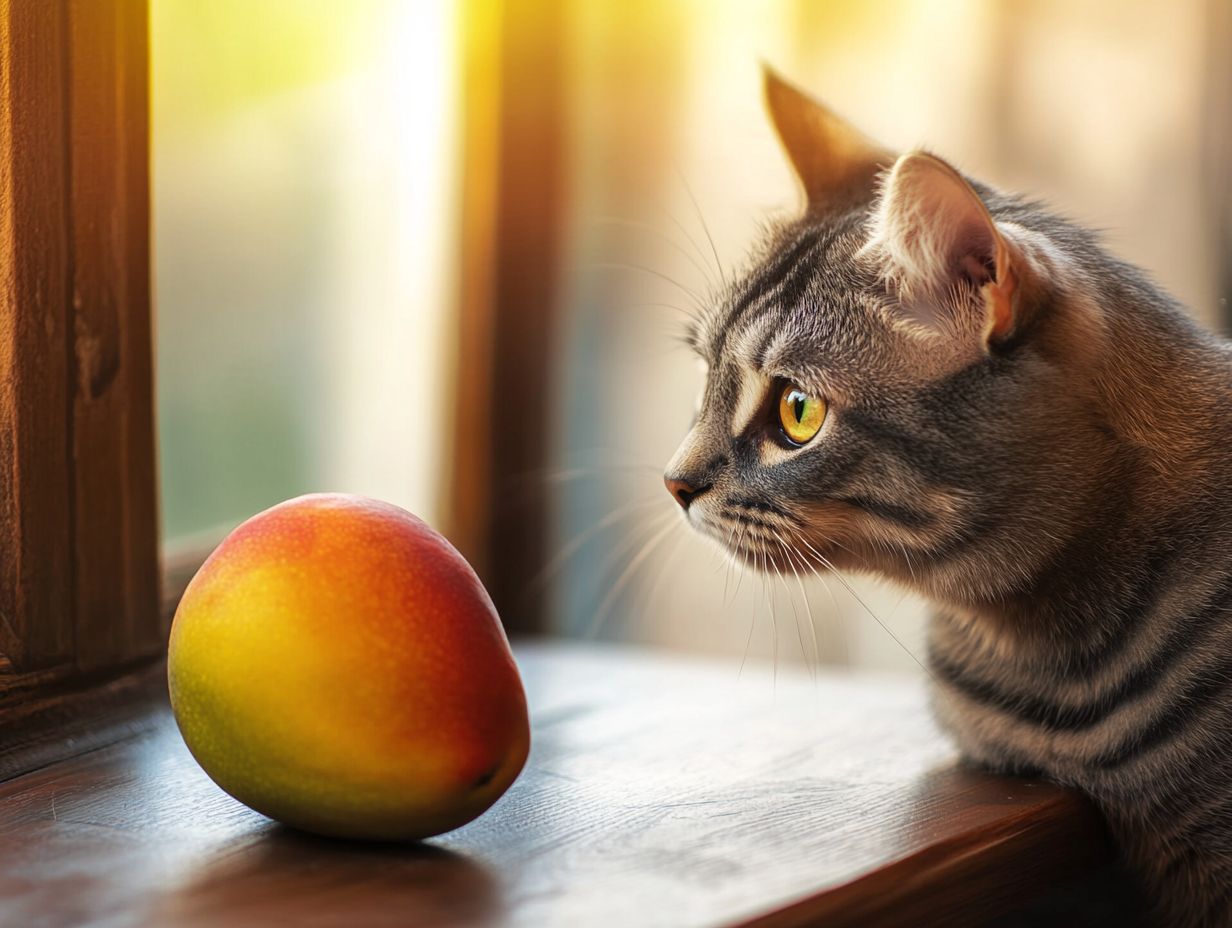Many cat owners wonder if they can safely treat their feline friends with fruits like mangoes. The main question is: Can cats eat mangoes? Yes, mangos can be a safe treat for cats in moderation, but there are important considerations regarding their nutritional benefits and potential risks.
This article explores the nutritional value of mangoes for cats, discusses potential risks—including allergic reactions and digestive issues—and shares tips on how to safely introduce this fruit into their diet. We’ll also provide alternatives to mangoes, such as strawberries and blueberries, so you can diversify your cat’s treats.
Keep reading to find out if this juicy treat is a good fit for your furry companion!
Key Takeaways:

- While cats are obligate carnivores and do not require fruit in their diet, small amounts of mango can provide beneficial nutrients such as Vitamin A, C, potassium, and fiber.
- Start with one small piece of mango (about 1-2 grams) and observe your cat’s reaction over 24 hours. If any adverse reactions occur, avoid feeding mangoes to your cat in the future, as they may lead to digestive issues.
- Always remove the skin, stems, and pits before feeding to prevent choking. Limit mango intake to occasional treats rather than a regular part of their diet.
Can Cats Eat Fruit?
Cats are obligate carnivores, meaning their dietary needs primarily focus on meat. While including fruit in a cat’s diet can introduce vitamins and antioxidants, it is essential to know which fruits are safe and the proper amounts to minimize the risk of digestive issues.
In moderation, fruits can be a fun addition to a cat’s diet, but they should never replace a balanced feline diet that consists of high-quality proteins.
What Are the Benefits of Fruits for Cats?
Fruits like blueberries contain antioxidants that can enhance overall health by neutralizing free radicals. Antioxidants such as beta-carotene, selenium, and vitamin C specifically support your cat’s skin, eyes, and immune system. Watermelon is hydrating and can aid the cat’s digestive tract, but it should be offered in small pieces to reduce choking hazards. Due to the high sugar content in many fruits, they should only be given occasionally and in small amounts to minimize the risk of weight gain or gastrointestinal upset.
Cats have a limited number of taste buds, which means they do not have a refined sense of taste. Start with very small amounts and monitor for any adverse reactions, as some cats may experience digestive disturbances when trying new foods.
While fruits can provide some benefits, cats do not require them in their diets, as they get all their essential nutrients from meat. Therefore, it is always best to consult your veterinarian regarding your pet’s specific dietary needs.
Nutritional Value of Mangos for Cats
Mangos are nutrient-rich fruits that can offer health benefits to cats when fed in small amounts. This tropical fruit is high in vitamin C, dietary fiber, and potassium, all of which can positively contribute to a cat’s overall well-being. Additionally, mangos provide folate, which is crucial for cellular health.
The antioxidants found in mango can support a cat’s immune system and promote healthy digestion when introduced appropriately. However, it is crucial to remember that these fruits should be offered in moderation due to their high sugar content, which can pose risks, especially for cats with diabetes.
What Nutrients Do Mangos Provide?
Mangos are rich in vitamins, minerals, and nutrients that contribute to a cat’s health. They contain significant amounts of vitamin C, which helps boost your cat’s immune response, and are a good source of dietary fiber, aiding digestion.
Risks of Feeding Mangoes
While mangoes can be safe for cats in moderation, there are potential health concerns to consider:
- Allergic reactions may occur in some cats.
- The high sugar content can lead to weight gain or exacerbate conditions such as diabetes.
- Improper preparation, such as leaving the skin or pit, can lead to choking or digestive issues.
Conclusion
In summary, mangoes can be a delightful treat for cats, but always remember to consult your veterinarian before introducing new foods into your cat’s diet. Being cautious and informed will help ensure your furry friend enjoys their treats safely!
Nutritional Benefits of Mangos
Additionally, mangos provide potassium, which helps regulate blood pressure and nerve function. The antioxidants found in mangos can combat oxidative stress, making them a potentially beneficial treat for cats when offered in moderation. These antioxidants protect cellular health, similar to the benefits found in other cat-friendly fruits like blueberries.
Make sure to prepare mango by peeling and removing the pit, as these can be harmful. Monitor your cat’s reaction; if they do not tolerate mango well, consider offering other fruits that are generally safer.
Practical Feeding Tips
How to Safely Feed Mangos to Cats
Mango can be safely fed to cats when prepared properly and offered in moderation to prevent any harm. It should be introduced in small amounts, ensuring that the skin, stem, and pit of the fruit are completely removed. Offer only 1-2 small cubes of mango, approximately the size of a pea, to gauge your cat’s reaction.
Tips for Introducing Mangos into a Cat’s Diet
When introducing mango to your cat for the first time, follow these guidelines:
- Start by offering only a small amount of ripe mango to minimize any potential digestive issues.
- Always ensure that the mango is fresh, and cut it into small, easy-to-chew pieces to prevent any choking hazards.
- Limit the portion size to just a few small cubes, about the size of a pea, to assess their acceptance.
- If your cat shows interest and has a positive reaction, you can gradually increase the portion size.
- Always monitor your cat’s reaction, as they may respond differently when trying new foods.
Additionally, you can offer other safe fruits such as blueberries and watermelon as alternatives to mango.
Conclusion
In summary, while mangos can be a delightful treat for your feline friend, it is crucial to remember that moderation and safety are paramount when introducing any new food into a cat’s diet. Always prioritize your cat’s primary nutritional needs, and consult with a veterinary professional if there are any concerns.

Safe Fruits for Cats
Blueberries, watermelon, strawberries, bananas, and apples are cat-safe fruits that can be offered in moderation. These fruits provide health benefits and contribute to your cat’s overall health, providing vitamins and hydration without overwhelming their digestive system.
Benefits of Fruits
These fruits can offer various nutritional benefits. For instance:
- Blueberries are low in calories and high in antioxidants.
- Watermelon offers hydration and essential vitamins.
- Strawberries are rich in fiber that helps digestion.
- Bananas provide potassium.
- Apples can contribute to your cat’s nutrient intake.
Risks of Feeding Fruits
While many fruits are safe for cats, some can be toxic, such as cherries, grapes, chives, garlic, and leeks. Always avoid these fruits. Additionally, feeding too much fruit can lead to digestive upset. If you notice any symptoms, consult your veterinarian.
Preparation Tips
Proper preparation is crucial when offering fruits to your cat. Follow these tips:
- Always wash fruits thoroughly.
- Remove skins, pits, and any inedible parts.
- Cut fruits into small, manageable pieces to prevent choking.
When introducing any new food, including fruits, observe your cat for any adverse reactions.
Moderation
It’s important to offer these treats in moderation. Stick to a small portion, such as one or two small pieces of fruit, or no more than 10% of your cat’s daily caloric intake.
Frequently Asked Questions
Can cats eat mangos and other fruits?
Yes, cats can eat mangos, but in moderation. They are high in sugar and should not be a regular treat.
Is mango safe for cats to eat?

Yes, mango is generally safe for cats to eat, but there are precautions to keep in mind, such as removing the skin, stems, and pit before feeding.
What are the benefits of feeding mangos to cats?
Mangos are a source of vitamins and minerals, such as vitamin C, beta-carotene, dietary fiber, and antioxidants, which can help boost your cat’s immune system and overall health.
Are there any risks associated with cats eating mangos?
While mangos are generally safe for cats, they can cause digestive upset if fed in large amounts. The skins and pits can also pose a choking hazard. Always offer small pieces as snacks.
How should I prepare mangos for my cat to eat?
Remove the skins, pits, and stems before giving mangos to your cat. You can also puree the flesh for easier digestion.
Can cats eat other fruits besides mangos?
Yes, other safe fruits for cats include bananas, apples, watermelon, blueberries, strawberries, cranberries, raspberries, pineapples, and papayas. Always check the safety of human foods and consult a veterinary professional regarding cats’ diets.
Conclusion
While mangoes and other fruits can be offered to cats, always prioritize moderation and proper preparation to ensure their safety and health.